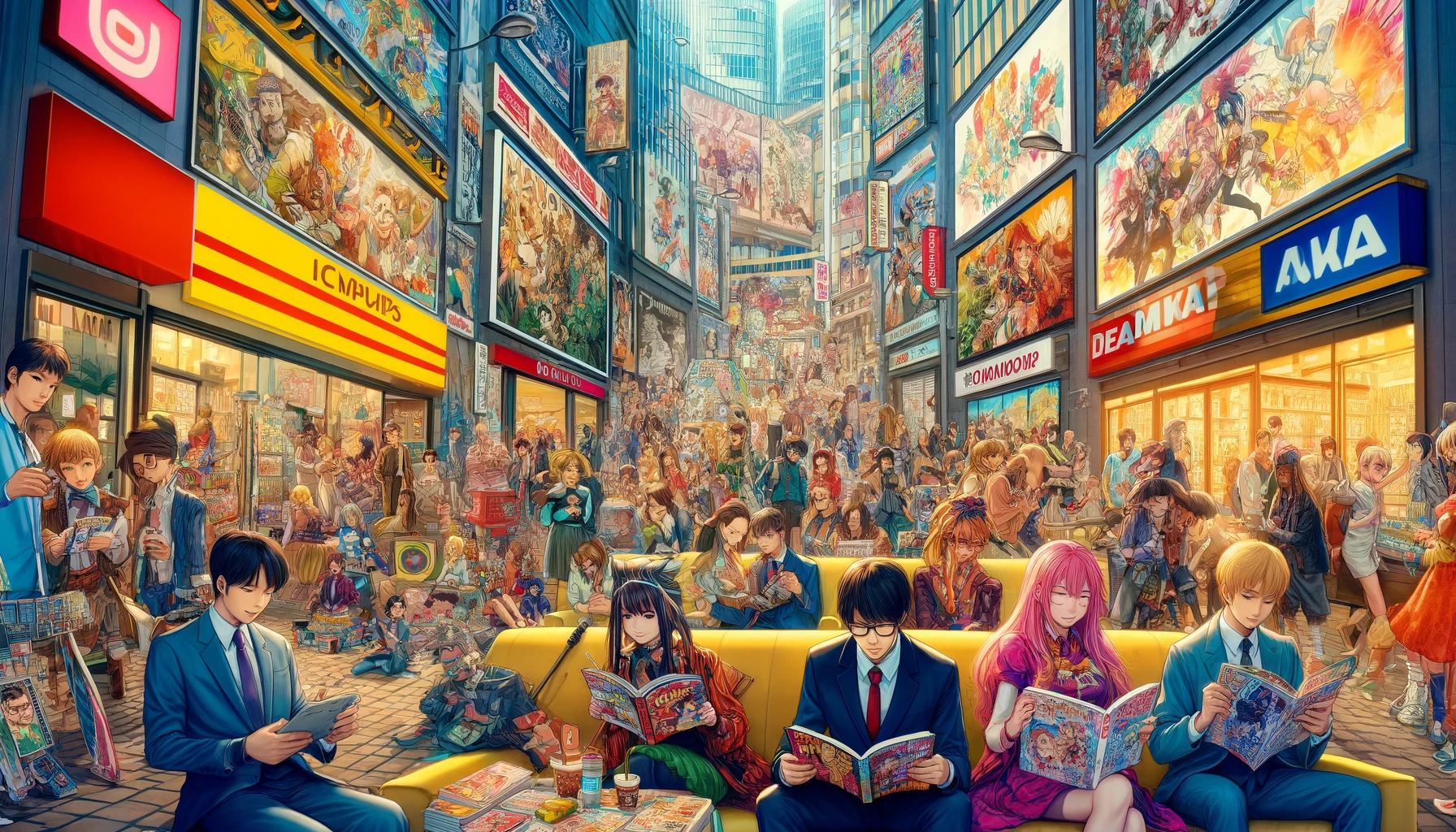Anime books have long been celebrated for their intricate narratives, vivid worlds, and unforgettable characters. Traditionally rooted in Japanese culture, these stories have often drawn heavily from Japanese mythology, folklore, and societal values. However, as anime has grown in global popularity, so has its ability to transcend cultural boundaries. In 2024, anime books are increasingly weaving in cross-cultural themes and global influences that create a more diverse and universally relatable reading experience. This shift not only enhances the appeal of anime books but also encourages cross-cultural understanding and appreciation.
In this post, we will explore how anime books are incorporating cross-cultural elements, examining how these themes shape the genre and what they mean for the future of anime literature.
1. Merging Eastern and Western Elements
One of the most exciting aspects of contemporary anime books is the merging of Eastern and Western cultural influences. While anime literature has traditionally been deeply rooted in Japanese aesthetics and storytelling conventions, modern authors are drawing inspiration from Western genres such as fantasy, science fiction, and even superhero comics.
This cross-cultural blending results in fresh, dynamic stories that resonate with a wider global audience. For example, anime books that incorporate Western fantasy elements—such as magic, dragons, or dystopian settings—are now being infused with traditional Japanese themes of honor, family, and self-discovery. This hybrid approach introduces readers to stories that fuse the best of both cultures, creating new experiences and broadening the genre’s appeal.
Example: A light novel set in a post-apocalyptic world where Japanese spirituality meets Western-style magic. The characters’ personal journeys are shaped by both Shinto beliefs and Western concepts of freedom and individuality, offering readers a unique, cross-cultural perspective.
2. Universal Themes for a Global Audience
At the heart of many anime books are universal themes that transcend cultural boundaries. Concepts like personal growth, the battle between good and evil, friendship, love, and self-discovery resonate with readers no matter where they come from. As anime books continue to explore these timeless ideas, they become increasingly relatable to global audiences.
For instance, many anime books center around protagonists on a journey of self-realization or characters who must overcome personal obstacles to find their place in the world. These experiences reflect core human emotions and challenges that readers from diverse cultural backgrounds can empathize with. By focusing on these universal aspects, anime books become a bridge between cultures, allowing fans worldwide to connect over shared experiences.
Example: A manga series following a young character who must face their inner demons and grow stronger, emphasizing themes of resilience and the human struggle against adversity—values universally understood, no matter the reader’s background.

3. Expanding Character Diversity
Incorporating a wide array of characters from different cultural backgrounds has become a key trend in anime books. As the anime community becomes more globally interconnected, stories now reflect this diversity. Many modern anime books feature characters who hail from different countries, ethnicities, and backgrounds. These characters bring unique cultural perspectives to the stories, enriching the narrative and offering readers a broader understanding of the world.
Moreover, as anime books become more inclusive, the representation of various cultures in both protagonists and supporting characters helps readers understand and appreciate the complexities of diverse societies. This expanded diversity promotes cross-cultural dialogue, fostering empathy and understanding.
Example: A light novel featuring a team of international characters, each from a different country, who must unite to face a global crisis. The characters bring their distinct cultural knowledge and values to the team, offering fresh perspectives on solving problems and building relationships.
4. Global Settings and International Influences
As anime books become more globalized, many stories now take place in diverse, multicultural settings. Authors are increasingly creating worlds where different cultures and traditions coexist, drawing inspiration from a variety of countries and historical contexts. This shift in setting allows for richer, more nuanced storytelling that explores cultural exchange and the complexities of global interaction.
By featuring settings that reflect the world’s diverse cultures, anime books can address global issues such as cultural misunderstandings, political conflict, and social dynamics in new and interesting ways. These stories not only entertain but also prompt readers to reflect on the impact of different cultural forces on the world around them.
Example: A manga series set in a futuristic city where characters from various countries live and work together. The story explores how these diverse cultures interact, form relationships, and navigate the challenges of living in a globalized world.
5. Drawing on Global Mythologies and Folklore
Anime books often draw from mythology and folklore to shape their characters, themes, and narratives. While traditional anime stories were largely influenced by Japanese folklore, there is a noticeable shift in modern anime books to incorporate myths, legends, and stories from various global cultures. This brings new dimensions to the genre, allowing readers to engage with stories they may not have been familiar with before.
By incorporating different mythological systems, authors introduce readers to new cultural traditions, deities, and moral lessons. This not only enriches the narrative but also provides readers with an opportunity to explore cultures and histories outside of their own.
Example: A light novel series that mixes Japanese mythology with Greek and Norse gods, where characters encounter figures from different pantheons, blending their stories to create a cross-cultural, mythological adventure.
6. The Role of Social Media in Promoting Cross-Cultural Themes
In today’s digital age, social media platforms have become essential in bringing anime books to a global audience. Fans from around the world engage with anime book communities, discussing plotlines, characters, and cultural references. This global network of fans helps to promote cross-cultural themes by sharing recommendations and highlighting lesser-known works that feature international influences.
Social media also provides a platform for anime book creators to interact with their fans, allowing them to receive feedback from a diverse range of readers. This engagement fosters a greater understanding of how cultural elements resonate with different audiences and can lead to more inclusive and global storytelling in anime books.
Example: An online community where fans from Japan, the U.S., and Europe share their thoughts on a new anime light novel, discussing how the book incorporates various cultural elements and influences.
7. The Future of Cross-Cultural Themes in Anime Books
As the anime book industry continues to evolve, the incorporation of cross-cultural themes will only increase. In the future, we can expect anime books to tackle a wider range of global issues, such as climate change, migration, and international politics, all while maintaining their cultural authenticity. The blending of different cultural perspectives will continue to shape the genre, creating stories that resonate with an ever-growing global fanbase.
By embracing cross-cultural themes, anime books are not just appealing to a wider audience—they are helping to break down cultural barriers and promoting a deeper understanding of the world we live in.
Conclusion: Embracing Global Influence in Anime Books
The integration of cross-cultural themes in anime books is an exciting trend that reflects the increasingly interconnected world of storytelling. As anime books embrace a global influence, they are becoming more diverse, inclusive, and relatable to fans from all corners of the world. Through the blending of Eastern and Western traditions, the expansion of character diversity, and the exploration of global settings and mythologies, anime books are pushing the boundaries of what anime storytelling can be. As this trend continues, anime books will play a crucial role in fostering cross-cultural understanding and uniting fans through shared narratives and experiences.











